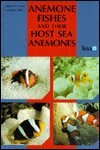A beautiful anemone playing host to a colorful Clownfish, is a popular icon of the reef aquarium!
Sea anemones have become very popular inhabitants for both the reef tank and the saltwater aquarium. Watching an anemone living in a cooperative relationship with a colorful Clownfish is a rewarding experience.
There are 10 types of anemones that will host clown fish as well as many other types available for the aquarium. Many species are very hardy, and with careful selection all levels of marine aquarists can enjoy keeping sea anemones.
Many anemone species are reasonably available, but each species varies in its aquarium hardiness and difficulty of care. When selecting a sea anemone it is important to choose not only a hardy specimen, but also a healthy specimen. It is also important to choose an anemone that is suitable for your aquarium type. Most types of anemones do well in a reef tank, but there are a few that are better kept in a saltwater aquarium rather than a reef environment.
Many types of anemones are known to be quite durable once they are established, but some anemones simply do not fare well in captivity, or are not the right choice for the aquarium. There are also some anemones to be cautious of, or to obtain only once you are well prepared. These include the Rock Anemones like Aiptasia, and the Stinging Sea Anemones from the Actinodendronidae family. Be sure to learn about the type of anemone you want so you can determine its needs and its suitability for your aquarium.
For information about setting up a reef tank see:Reef Tanks – Mini-Reef Aquarium Basics
Types of Sea Anemones
- The Sea Anemone
Order: Actinaria
Sea Anemones are in the order Actinaria, and are often called the “true anemones”.
They have an adhesive pedal disc or foot used to hold them in place, a hollow cylindrical or column shaped body, and an oral disc, or mouth, at the top which is surrounded by a circle of tentacles containing stinging nettle-cells or nematocysts. These stinging cells are used to capture prey and push it into its mouth. With only a slight touch, the tentacles shoot harpoon-like filaments into passing prey, injecting it with a paralyzing neurotoxin, and then guiding it into the mouth. - The Tube Anemone
Order: Ceriantharia
Tube Anemones are in the order Ceriantharia. They are also known as Tube-dwelling Anemones or Burrowing Sea Anemones. They are solitary animals, living and withdrawing into tubes that are buried in soft sediments.
Tube Anemones look very similar to sea anemones, but they have elongated bodies adapted for burrowing and they lack the pedal disc or foot. The cylindrical shaped body is covered by a tube of secreted mucous and is usually hidden in the muddy substrate. The mouth is on a central disk, surrounded by short tentacles in the center and longer tentacles on the margins. Usually only the tentacles are visible above the ground.
Sea Anemone Stings
Some anemones with strong stings are the Carpet anemones in the Cryptodendrum genus (previously Stoichactis) and the Heteractis genus, Condy Anemones in the Condylactis genus, Tube Anemones in the Pachycerianthus genus. Those with very dangerous stings are the ‘stinging sea anemones’ belonging to the family Actinodendronidae.
Anemone Stings: Most anemones, when you touch them feel slightly sticky. They can cause a stinging sensation or even a rash. The area affected can start as a rash that spreads quickly. For most people this is just an irritation, but some people can be allergic to the poison and may have a more severe reaction. In rare cases it can cause anaphylactic shock which is a complete shutdown fo the respiratory system.
Treatment For Anemone Stings: Stings from an anemone or from a venomous fish can be painful. To relieve painful stings, provide treatment right away. This treatment can also be used to relieve the pain from the stings of venomous fish.
- First rinse the area with vinegar or alcohol.
- Then make a paste, half and half of sodium bicarbonate and water, and cover the wound.
- Finally, after the paste dries, dusting the wound with talcum powder or papain (ingredient sold as a meat tenderizer) can help neutralise the venom.
Hardy Aquarium Anemones
Some anemones are easier to keep than others. The best anemone survival rates that we have found are among the smaller anemones and also one of the carpet anemones, the saddle anemone. Another anemone that is very common is the Bubble Tip Anemone Entacmaea quadricolor, also called the purple base or pink tip anemone. This is fortunate since many different kinds of clownfish will accept the purple base anemone as a host.
Clownfish host anemones that are easier to keep include:
- Bubble Tip Anemone Entacmaea quadricolor
- Saddle Carpet Anemone Stichodactyla haddoni
- Long Tentacle Anemone Macrodactyla doreensis
- Delicate Sea Anemone Heteractis malu
Other hardy anemones include:
- Condy Anemone, Giant Golden Anemone Condylactus gigantea
- Tube anemone species (Burrowing Sea Anemones)
- Glass Anemones in the Aiptasia genus (though these are also considered to be pests!)
Some of the more difficult anemones to keep include:
- Sebae Anemone Heteractis crispa
- Giant Carpet Anemone Stichodactyla gigantea
- Magnificent Sea Anemone, Ritteri Anemone Heteractis magnifica
We have found that anemones are often challenging. We have purchased almost every anemone available and have read surveys taken in an attempt to determine the survival rate of anemones once they enter into the aquarium industry. In both cases the survival rate is very low, particularly among the larger carpet anemones. This is unfortunate as the larger carpet anemones are natural hosts for a number of anemone fish, but fortunately clown fish will take other kinds of anemones as hosts.
One of the best books we have found on anemones and their care, and the main reference for information presented here, is the book seen to the right above. It is the “Field Guide to Anemonefishes and their Host Sea Anemones” by Daphne G. Fautin & Gerald R. Allen. Both of these authors believe that carpet anemones should not be removed from the oceans for the aquarium trade.
Clown Fish Anemone
Sea anemones have special relationships with other animals and organisms, where each animal helps the other in some way. Perhaps the most well known relationship is that of some sea anemone species providing a home and protection for clownfish. In return the clown fish help the anemone by cleaning its tentacles of detritus, and possibly running off potential predators.
Though there are over 1100 types of sea anemones, only 10 species are known to host Clownfish:
- Adhesive Sea Anemone Cryptodendrum adhaesivum
- Bubble Tip Anemone Entacmaea quadricolor
- Beaded Sea Anemone Heteractis aurora
- Sebae Anemone Heteractis crispa
- Magnificent Sea Anemone, Ritteri Anemone Heteractis magnifica
- Delicate Sea Anemone Heteractis malu
- Long Tentacle Anemone Macrodactyla doreensis
- Giant Carpet Anemone Stichodactyla gigantea
- Saddle Anemone Stichodactyla haddoni
- Merten’s Carpet Anemone Stichodactyla mertensi
Buy Sea Anemone
Successfully keeping an anemone is often dependent upon choosing a healthy specimen when you buy sea anemones. This checklist provides some things to avoid when choosing an anemone:
- Loose or open mouths
- Tentacles that are short when they should be long, or skinny when they should be fat
- There should not be any tears on its foot
- An anemone should be a little bit sticky.
- Coloring – if an anemone is white, it may have released its zooxanthellae that it depends on for much of its food. This can spell disaster over time.
- Anemones that are not attached to anything may have trouble attaching.
- Anemones contract when they feel threatened, make sure the anemone you get reacts when it is picked up
There are many naturally colored anemones, but occasionally artificially colored anemones are offered for sale. Primarily these are Sebae or Ritteri Anemones colored with vegetable dyes or other dyes to increase their salability. This coloring doesn’t add to the anemones vitality, nor does it last.
Sea Anemone Pictures
Rock Anemones – Aiptasia Anemones and Relatives
Family: Aiptasiidae

Genus: Aiptasia
Aiptasia anemones are so hardy and invasive they are considered as Aiptasia pest anemones in mini-reef aquariums. Another pest anemone is the Manjano Anemone or Majano. Many articles have been written on how to get rid of pest anemones, from injecting them with kalkwasser, to using aquastick (an underwater epoxy) to seal them into a hole in the rock! Apparently if they are smashed or removed by hand, small pieces of the anemone will re-grow to adult Aiptasia. Aiptasia are not used by clownfish probably because they are too small.
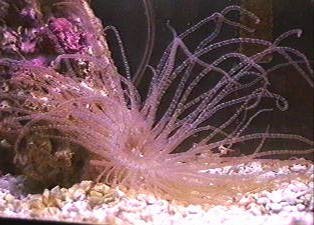
Curlicue Anemone
Bartholomea annulata
The Curlique Anemone is a sea anemone in the Aiptasiidae family that is not as much of a pest. It has beautiful, delicate tentacles. It prefers medium to high light conditions but will survive in low light as well. This is not a clownfish host.
Clown Fish Anemone – Host Anemones
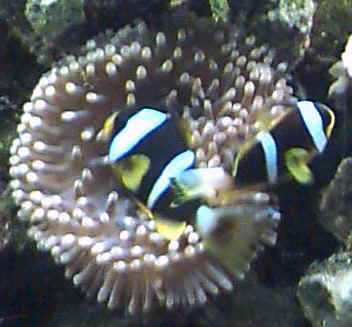
Bubble Anemone- with two Sebae Clowns
Entamaea quadricolor
Photos © Animal-World
The Bubble Tip Anemone is a hardy anemone that likes medium to strong light and does well in aquariums. Many different kinds of clownfish will accept it as a host. We had a pair of Cinnamon clowns breed in a bubble anemone repeatedly for over a year. Pictured with the anemone above are Sebae clowns.

Saddle Anemone
Stichodactyla haddonni
Photos © Animal-World
The Saddle Anemone or Carpet Anemone has a lot of very short tentacles. They are very adhesive to human skin. If you touch one it will stick fast, sometimes to the point of pulling the tentacles out of the anemone when you detach it. The one pictured above is a rarer form of the Saddle anemone which has lighter stripes running from the mouth (center) to the outside edge. The Saddle anemone is by far the hardiest of the carpet anemones. It likes strong light levels.
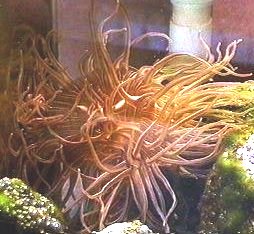
Long Tentacle Anemone
Macrodactyla doreensis
The Long Tentacle Anemone will get fairly large (we have one that is the size of a dinner plate) and is accepted by many different kinds of clownfish. We have personally seen Tomato, Sebae, Percula, Skunk, and Maroon clowns accept it as a host. They are usually hardy and easy to keep as long as you have medium to strong light.
Tube Anemone – Burrowing Sea Anemone
Genus including: Pachycerianthus, Ceriantheopsis. Cerianthus

This is a variety of tube anemone but we’re not sure what species
Tube anemones are some of the few sea anemones that do well in low light levels. The name ‘ tube dwelling anemone’ is derived from their ability to build a tube to live in. It was previously believed that they created their tube by releasing a mucus, which then become covered with sand. Today however, it is known that they create the tube by releasing threads of a special type of nematocysts called ‘ptychocyst’. The result is a woven fibrous structured of stinging cells that help protect it from attack. Though its tentacles are non-retractable, if it is frightened or disturbed it can instantly withdraw its whole body into the tube and become hidden
They are nocturnal and should be fed finely chopped fish and shrimp every other day or so. Tube anemones are found in all the warm water oceans of the world. Their long tentacles have a powerful sting and therefore should be kept away from other anemones and corals. They are not used as hosts by clownfish.
Sea Anemones – Other Types of Anemones
 |
| Color Variations |
Condy Anemone, Giant Golden Anemone, Caribbean Anemone |
The Condy Anemones are inexpensive anemone which come from the Caribbean, thus the name Caribbean Anemone. They are usually very hardy and come in several colors. The most attractive have purple tipped tentacles. Condylactus like high light levels but will do okay in low to medium light. These anemones are the most inexpensive and are very hardy. They can do well in any marine aquarium, not just reefs.
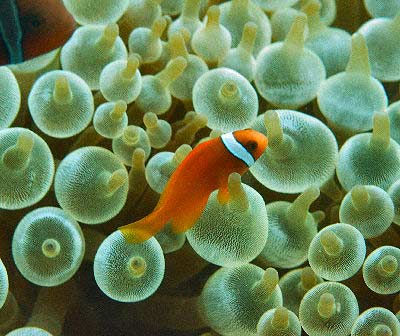














AnemoneWRA_Ap8R_vsm.jpg)




















